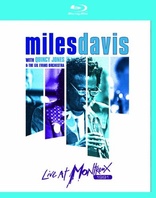
Original title: Miles Davis with Quincy Jones & the Gil Evans Orchestra - Live at Montreux 1991
Year: 2013
Genre: Cool Jazz, Bop, Progressive Jazz, Big Band, Modern Creative
Cast and Crew:
Miles Davis - trumpet
Quincy Jones - conductor
Kenny Garrett - alto saxophone
Wallace Roney, Benny Bailey - trumpet, flugelhorn
Carles Benavent - bass
Grady Tate - drums
The Gil Evans Orchestra:
Alex Foster - soprano & alto saxophones, flute
George Adams - tenor saxophone, flute
Lew Soloff, Miles Evans - trumpet
Tom Malone - trombone
Gil Goldstein, Delmar Brown - keyboards
Kennwood Dennard - drums, percussion
The George Gruntz Concert Jazz Band:
George Gruntz - piano
Sal Giorgianni - alto saxophone
Larry Schneider - tenor saxophone, flute, clarinet, oboe
Bob Malach - tenor saxophone, flute, clarinet
Jerry Bergonzi - tenor saxophone
Howard Johnson - baritone saxophone, tuba
Marvin Stamm, John D'earth, Jack Walrath - trumpet, fluegelhorn
Dave Bargeron, Earl McIntyre - trombone, euphonium
Dave Taylor - bass trombone
John Clark, Tom Varner - French horn
Mike Richmond - bass
John Riley - drums, percussion
• In the 1950s, jazz trumpeter Miles Davis and musical arranger Gil Evans formed a relationship that would become legend. The collaboration resulted in some of the most seminal recordings in the jazz catalogue, including Miles Ahead (1957), Porgy and Bess (1958) and Sketches of Spain (1960). These albums, with their lavish orchestral arrangements, modal music, and innovative soloing from Miles Davis would set a standard for jazz for years to come. Unfortunately, given the size requirements of the orchestrations and budget constraints, it would mean that much of the music would rarely, if ever, be performed live in its entirety during that period. And for Miles Davis, once the period was over, it was over. Miles was never one to look back. By the mid to late 60s, Davis was already moving on to fusion, and through the 70s and 80s, he would be traversing many other musical terrains, from funk to rock to soul. He had no desire to ever go back and perform these much beloved arrangements. It would be the death of his longtime friend and collaborator Gil Evans in 1988 that would finally bring him around, but not without much arm twisting from friends music producer and jazz musician/composer Quincy Jones and Montreux jazz Festival organizer Claude Nobs. In 1991, the festival finally went on, Davis, ill (the musician would pass away only three months after this concert) and still not eager to even rehearse the pieces, finally showed up to perform what would be a grand event. Quincy Jones conducted the Gil Evans Orchestra (including Gil Evans’ son Miles Evans on trumpet) and the George Gruntz Concert Jazz Band. It was Jones’ decision to double the orchestration to avoid having the woodwinds drowned out by the brass instruments. Trumpeter Wallace Roney shared the trumpet solos with Davis, while Davis’ saxophonist Kenny Garret was included as well.
• The repertoire for the July 8, 1991 concert, made up mostly of music from Miles Ahead, Porgy and Bess, and Sketches of Spain, begins with a continuous suite of six tracks, beginning with “Boplicity” from the the early classic The Birth of the Cool. It continues on with “Maids of Cadiz,” “The Duke,” “My Ship,” “Miles Ahead” and “Blues for Pablo.” Then it shifts to music from Porgy and Bess, tackling a rambunctious rendition of “Orgone,” a fleeting “Gone, Gone, Gone,” which transitions into a smooth as silk performance of “Summertime” and then a version of “Here Come De Honey Man” reminiscent of something off of Van Morrison’s Astral Weeks or Veedon Fleece. Or, perhaps I should say, the latter are reminiscent of the former. The show concludes with two pieces from the Spanish-influenced, Sketches of Spain, “The Pan Piper” and a riling 12-minute version of “Solea.”
• While it is evident early on that Davis was not near his peak at all performance-wise during this concert, his sound is unmistakable. The yearning screech of his muted trumpet is uniquely Davis, and there are moments where he blows a note that hits right in the chest. However, it is the brilliant efforts of Quincy Jones (himself a classical scholar trained by none other than Olivier Messiaen) to bring the arrangements of Evans to life, and the support of Wallace Roney and Kenny Garret that make this Miles Davis concert, his last appearance at Montreux, a jazz triumph.
Setlist:
Recorded live at the 25th anniversary of The Montreux Jazz Festival, Montreux, Switzerland on July 8, 1991.
1. Boplicity
2. Maids of Cadiz
3. The Duke
4. My Ship
5. Miles Ahead
6. Blues for Pablo
7. Orgone
8. Gone, Gone, Gone
9. Summertime
10. Here Come De Honey Man
11. The Pan Piper
12. Solea
Bonus:
• Claude Nobs Interview (480i; 27:04) This is a wonderful set of reminiscences from Nobs, who recounts quite a bit of his extended history with Miles.
• About Miles Davis (480i; 46:19) includes briefer interviews with many legendary players who provide some great anecdotes about him. These include Monty Alexander, Helen Merrill, Betty Carter, Charlie Haden, Gil Goldstein, Stanley Clarke, Jean-Luc Ponty, Al DiMeola and Michel Petruccianni.
 淘宝店铺:http://94hd.taobao.com
淘宝店铺:http://94hd.taobao.com